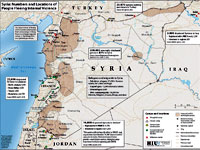RIA Novosti: Russian Expert Decodes Information On Shells Found In Syria By UN Inspectors

(RIA Novosti – Valday, Novgorod Region, September 17, 2013) The parts of Soviet-made munitions found by UN inspectors near Damascus belong to projectiles used in multiple-launch missile systems that the Syrian army took out of service long ago and have probably been improvised to carry chemicals, the director of the Centre for Analysis of Strategies and Technologies, Ruslan Pukhov, has told RIA Novosti.
UN inspectors published on Monday (16 September) a report on the use of chemical weapons near Damascus. They concluded that either manufactured or makeshift warheads could have been used in the missiles. There was Cyrillic script on the remnants of the propulsion unit of one of the missiles.
“The first projectile is easy to identify and it is named in the report – a 140-mm M-14-series rocket projectile from an old Soviet-made BM-14-17 multiple-launch system from 1952. The number 179 is found twice on the projectile and this is the factory number – Sibselmash in Novosibirsk, one of the USSR’s main producers of various types of unguided rocket projectiles. The code 4-67-179 means 4th batch in 1967 by factory 179,” Pukhov said.
“In any event the Soviet Union is unlikely to have supplied chemical projectiles to Syria. So an old munition has clearly been improvised to take chemicals. We know that the Syrians took the BM-14-17 out of service long ago and M-14-series projectiles for that weapon are long past their storage deadlines,” he said.
According to Pukhov the Syrian army is unlikely to be able to use such weapons. “If they wanted to use chemical munitions then they probably would not have wanted to risk it with antiques like these and instead would have gone for the BM-21 Grad, for which they probably do have chemical munitions. But the insurgents could have found this ancient junk after capturing some military storage depot,” he continued.
“A second projectile of 360 mm calibre is not a manufactured product but looks home-made. The Syrian army is unlikely to be making and using such primitive munitions,” he said.
